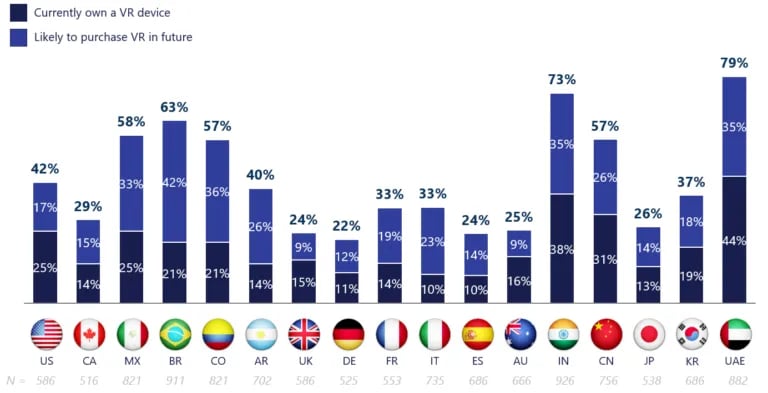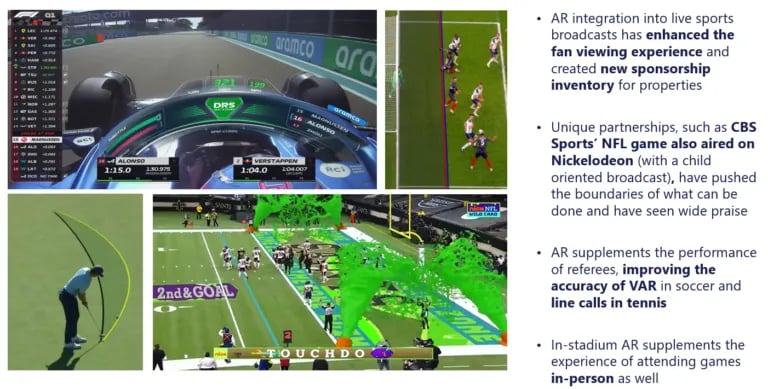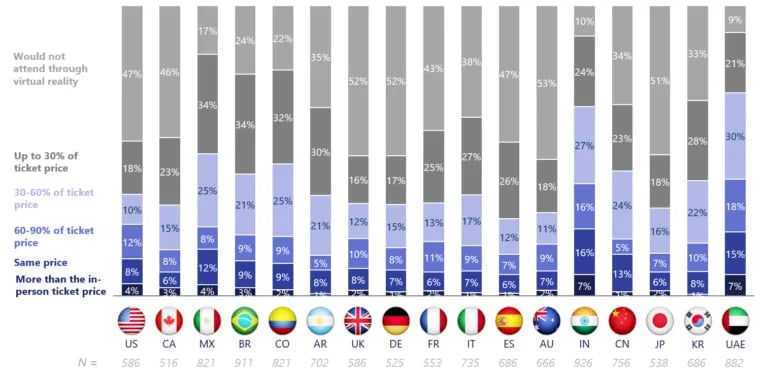INSIGHTS
AR/VR: Game changers for increasing sports fan engagement and monetization
Altman Solon’s 2022 Global Sports Survey shows fan interest in using augmented and virtual reality in sports, as many leagues and teams embrace the technologies to grow reach and engagement with fans.
Augmented reality and virtual reality (AR/VR) are poised to change the way fans engage with sports. From the rise of AR during live sports broadcasts to being able to watch NBA and English Premier League games in virtual reality, these interactive and immersive technologies provide new ways to engage fans and monetize sports assets and IP. Findings from Altman Solon’s 2022 Global Sports Survey suggest that this technology is attracting the attention of sports fans, as sports rights’ holders, leagues, and teams explore ways to use AR/VR to create more engaging fan offerings and experiences and new opportunities for partners and sponsors.
Many sports fans own or plan to purchase a VR device
VR device ownership
% of monthly sports viewers in each country that currently own or are likely to own a VR device in the next three years

Fan awareness of AR and VR technologies in sports is still relatively low globally, with only 20% of sports fans familiar. In Europe, less than 20% of sports fans are aware of the technologies’ uses in sports, while markets with higher awareness include the U.S., Brazil, India, and the UAE, with roughly a quarter of regular sports viewers aware of AR/VR.
However, a small but rising cohort of sports fans owns or plans on purchasing a VR device in the next three years. So, despite lower awareness today of AR/VR applications in sports, fans are primed to benefit from the technology in the future. This data is mixed across countries with Brazil, Mexico, India, and the UAE boasting a significant number of sports fans who own or are planning to own a VR device within the next three years, making them fertile markets for engaging with fans through AR/VR.
AR in Sports: Strong for player stats, odds, and biometrics
AR live action overlays
Case studies

AR overlays can add extra context to games, improve the accuracy of referees, and give fans new ways to interact with their favorite teams. An example of AR in action is the Formula 1 dashboard overlay that shows live car and driver data, including speed, gear, throttle, and break levels. Similarly, the National Hockey League (NHL) launched NHL Edge – an AR overlay highlighting player stats, skating speed, and advanced probability odds – for viewers who tune into games via smartphone. This investment in AR for live stats aligns with our findings: among sports fans surveyed, live stats and player data were particularly appealing uses of AR in sports. This interested fans in Latin America in particular, with 61% of sports fans in Brazil and 45% in Mexico reporting being ”very interested” or ”somewhat interested” in AR player stats. Other use cases that interested fans include live player biometrics and trending social media comments. AR overlays can also engage a mobile-first viewing public and provide teams with new sponsorship opportunities.
VR Games: Bringing your fans to the action, wherever they are
Willingness to pay for a sporting event ticket in VP, compared to in-person
% of monthly sports viewers in each country

VR can enhance fan engagement through virtual fan experiences, stadium tours, and live games. With growth on the horizon for VR device ownership and immersive digital worlds slowly entering the mainstream, the sports industry is leveraging this technology to deliver new viewing experiences. Currently, the NBA broadcasts 1-2 games per week in VR and both the English Premier League and World Wrestling Entertainment (WWE) have partnered with Meta to provide VR viewing experiences. VR should be taken seriously as a future revenue stream—according to our findings, most sports fans would be willing to pay to attend sporting events in virtual reality.
In China, for example, 66% of sports fans are willing to pay to watch a game in VR. Considering the NBA has some 300 million fans in China, giving them the possibility to get a courtside experience without having to leave their country (let alone their living room) is an enormous opportunity. The amount that sports fans would pay for their ticket varies by country. Leagues should experiment with pricing models to better understand what price points would create traction.
AR and VR technologies are changing the way sports are consumed, making them more visual, interactive, and engaging for fans. As sales for AR/VR devices are projected to rise, sports rights’ holders, teams, and leagues have everything to gain by investing in this technology and experimenting with ways to increase fan engagement, reach new audiences, and create new revenue opportunities.
More data on sports fans’ awareness of AR/VR in sports and their interest in specific use cases can be found in Altman Solon’s 2022 AR/VR in Sports report.